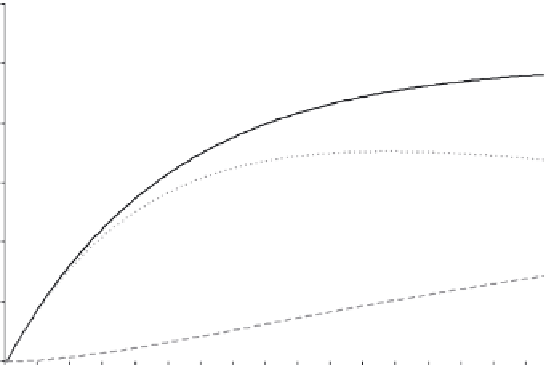Biomedical Engineering Reference
In-Depth Information
1,2
1
0,8
0,6
0,4
0,2
0
1
FIGURE 7.9
Sedimentation and uptake of AlOOH (22.5 µg/mL) by a NR8383 macrophage.
Development of particle numbers was normalized to the maximum and smoothed by model-
ing. The parameters
q
= 0.04/min and t = 234 min were derived from the best fit of modeled
and measured AlOOH data. Control ROI,
N
C
(
); active ROI,
N
P
(
);
, measured values,
number of phagocytized particles (
).
counting results of an active ROI from those of a control ROI is feasible in principle,
there may be a considerable variation in counting results. This can be due to small
particle numbers or due to a movement of particles caused by advection or mixing
(Hinderliter et al. 2010). Therefore, it appeared advisable to include into calculation:
(a) the variance of particle quantity inside the control ROI and (b) the description of
the sedimentation process according to the sedimentation model. As outlined earlier,
this model allows us to calculate the termination of the sedimentation process (
t
0
) for
a defined particle mass per volume and also to predict the number of particles per area
for every point in time. Thus, the particle counts within the control ROIs served for
adjusting the modeled values to the real measurement result. To automatically ana-
lyze this process on a single cell basis, all steps previously outlined were integrated
into a computer program termed “AM Tracking,” which standardized the image anal-
ysis to quantify particle phagocytosis of macrophages from time-lapse images.
7.3.2.3 Model-Based Description of Phagocytosis
The increase in particle quantity over time in a control ROI (
N
C
) and the particle
quantity in an active ROI (
N
P
) can be described through a kinetic model, where
N
P
is
the ratio of time-dependent particle number
N
(
t
) and maximum number
N
0
of observed
particles with 0
≤ N
C
≤
1. The kinetic model is based on a simple relation between the
rate d
N
P
/d
t
and the actual number of particles
N
C
(
t
). We empirically found that the
rate d
N
C
/
d
t
(approximately calculated from the change in particle number Δ
N
C
within
a constant time interval Δ
t
) linearly decreased with increasing
N
C
:













Search WWH ::

Custom Search